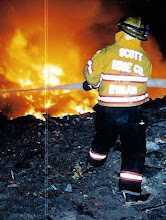Initially, only Chief’s had portables, then company
officers, and now everyone. The rapid
expansion in radio availability turned the fire ground from a nice quiet,
pleasant place, into a cacophony of noise, squeals, screamers, and those that
loved the sound of their own voice.
Eventually, most places establish communications policies that reined in
the worst offenders, but you can still hear the white noise in some areas.
Interoperability became the next buzz word, with the so
called need to be able to talk to the world, and as the size of radios
decreased, the channel capacity increased until the hundred channel radio
became ubiquitous. Most of these units
would live, die, and be replaced with the next latest and greatest model
without ever having used more than ten percent of the channels they contained,
but it was critical to have the secondary fire police channel of some
department three counties away that you had never, in the history of the
department, ever run with.
Now the radios will talk to you, Siri-like, although they
won’t answer questions –yet, or tell you where to get a good pizza on the way
back to the station (hint, hint Mr. Motorola—just kidding). The radio lady, Sophie I’ll call her, tells
you what channel you’re on. Good thing,
cause it’s not like I can remember who or what is on channel 63.
The extension mics have started to grow also, and now are
almost as big as the radios they are attached to. Speaker and mic button aren’t enough now;
volume controls and a mayday alert, all of which supposedly can be worked by
gloved hands in the dark. Good
luck. Makes me wonder why we need the
extension mics anymore—just attach the radio to the collar.
Technology is a wonderful thing, but the complexity has
reached the level that I pine for the days when you didn’t need an electrical
engineering degree to use a portable. Maybe, just maybe, RCA will start making radios again.




No comments:
Post a Comment